LEVEL 1
THE TOOL
🎮
You have arrived at the first chapter, The Tool, where your travel will begin. In most games you will get an item which will help you progress the game, for instance a two-handed war axe to slay your enemies or a wearable computer which tells you how many hit points (HP) or rolls of cheese you have left in your inventory. These are tools necessary for completing the game.
Video game platforms can be used as a tool for a variety of things; to let people connect, to serve for educational purposes, to explore worlds, as a creative medium or even as a business. This chapter will explore and elaborate on these functions.
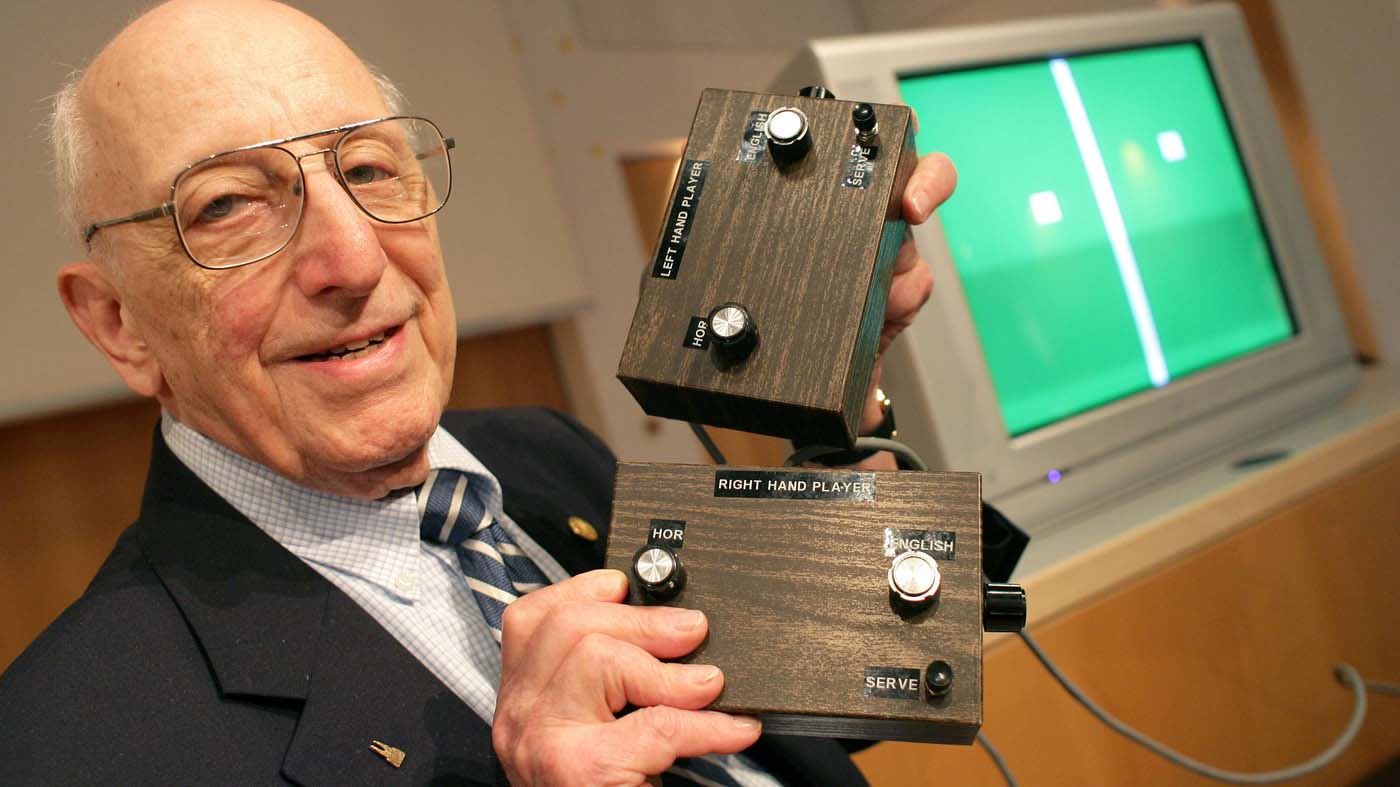
↳ Ralph Baer, inventor of the first video game console.
START NEW GAME
→ a tool to harness power and feel in control
“But in video games, I wonder sometimes if something much more subtle and instinctive is going on. Perhaps games aren’t really about power, they’re actually more about agency—the idea that we can have any sort of influence and control over what happens to us, and the world around us.” – Keith Stuart in The Guardian [1]
One aspect of playing a video game which interests me is the control that you get within the boundaries provided by the game; you are in control of the world on your screen. Playing a videogame gives a sense of power and responsibility and
even
comes very close to reality itself. For instance, in Red Dead Redemption 2 (RDR2), in which you have to eat, bathe and sleep to maintain your character. You are responsible for how your character feels and interacts, just like in the real
world
in which you also have to take care of yourself to survive. While it intrigues me how close RDR2 comes to reality there are also negative aspects in the game, which are manifested in the real world. To be able to get this information you will
need to reach level 3 in my thesis.
While I agree with Stuart on how agency is an important factor, I think power can be and often is an important of video games, as there are a wide variety of video games exactly centered around that principle; on having power and being able to conquer. In Age of Mythology you have to conquer all the other players to win the game and in most shooters you want to come out on top of the others and be the most valuable player (MVP). In games like God of War (GoW) the elements of power drive the game's narrative. A game protagonist who is regarded as a nobody or who has lost everything valuable to them, changes their fate to regain their status, to become the glorious hero in the story. Kratos, one of the characters in GoW, was tricked by the gods to kill his own family. He sets out on a journey to seek revenge on the gods, which he ultimately achieved by killing all the gods that ever stood in his way. You feel very powerful during this game, since you slay thousands of beings which are ten times the size of your character. Although all these games do indeed emphasize a sense of agency, this agency is arguably highly amplified by the concept of power and domination.
The aspect of power is not only visible in the video game itself; it’s industry’s power and control is continuously growing, since the arcades were introduced to the general public in 1970. Ever since its making rapid advancements, like the quality of gameplay has made huge leaps. Since gaming has made its way into the mainstream, the influence of video games is growing, there are even movies being made about video games, such as Lara Croft (2001) and Sonic the Hedgehog (2020). Every year the gaming community is expanding significantly and acquiring more people who want to game. Since more than 59% of the global population has access to the internet,
[2]
the amount of people who can access games is also growing. While this accounts for more joy, there are also problems emerging. Unfortunately, you just need a bit more experience to be able to access this information. You will be ready in the
next chapter!

↳ Gabriel Orozco, Ping Pond Table (1998).
ONLINE AND OFFLINE
→ a tool to connect or disconnect
Gaming has always played a big role in my life in regards to interaction with others. I used it to connect with friends, but also used it to isolate myself, to get into my own “dream” realm. Where I felt safe from the outside world and I could do whatever I want.
Oceanis2:
Fishing levels?
Zezima:
99
MrDoublerGp:
73
Oceanis2:
Nice
MrDoublerGp:
What's your level?
Oceanis2:
43
MrDoublerGp:
Sweet
MrDoublerGp:
What is your goal
Oceanis2:
I want 99 fishing
Zezima:
Keep grinding
MrDoublerGp:
You have a long way to go
MrDoublerGp:
GL
MrDoublerGp:
I just do it for the money
MrDoublerGp:
I already made bank
Zezima:
I have to go seeya
Oceanis2:
Nice
Oceanis2:
Let's add?
MrDoublerGp:
Yes, I added you
The conversation above is an example of one of the many conversations I had in Runescape (a free to play massively multiplayer online role-playing game (MMORPG)). In Runescape you are able to chat, trade and play minigames together with other players. These mechanics make it a very open and social platform to communicate with others. To get better at the game you have to train your skills, by leveling them to a higher level. Skills like fishing served the perfect opportunity to chat with other players, since there was a lot of waiting time for the fish to bite. To make conversation it was very normal to ask other players what their fishing level was and make a deeper connection from there on, I remember countless of these small interactions, like the chat from Oceanis2 (me) and others. While Runescape only makes use of text chatting, other games used voice chat as an interaction tool. As I got older I started playing Destiny (a online-only multiplayer first-person shooter), in which you have to take on outer galactic monsters.
Oceanis2:
Someone take the left pillar!
Player 4:
I take left!
Player 5:
I already took right
Oceanis2:
Shit!
Broeskinator:
Ahh, we died
Player 5 left
Player 4 left
Leviathan:
Sorry, I can't focus today
Player 6 left
Broeskinator:
Lets try another one?
Oceanis2:
Whats up?
Leviathan:
Mann, im failing school, but i don't care
Broeskinator:
Put in a bit more effort please
Oceanis2:
Why?
Leviathan:
I just cant focus at school, everybody is so noisy
Broeskinator:
And at home?
Leviathan:
Can't focus there either, my parents just got a divorce and are fighting all the time
Oceanis2:
That's fucked up man, did you talk with the heads of your school?
Leviathan:
No, but i should do that, thanks
Oceanis2:
Any time man
Broeskinator:
You can tell us everything man, my parents got a divorce 2 years ago, which was also a tough period for me
Leviathan:
Thanks guys, lets try another round
Broeskinator:
Let's find some others to join our fireteam
Oceanis2:
Letsgo!
To be able to play raids (end-level content), you needed a 6-player squad to play, therefore you had to go on forums and ask other players to join your fireteam. To succeed in a raid every player in the team needs to have a working microphone, since there was a lot of communication involved. Playing a raid usually took more than an hour, so there was a lot of time to get your fellow players on a personal level. I remember talking about school, how their days were... Even to this day if I go online on my PlayStation 4 the invites are popping up from old virtual friends, asking to play games together. There are a lot of people having a hard time making friends in real life and the medium of video games is a gift for them. Video games serve as a platform on which people can reach out and connect with others while staying unknown or known. Some people do not want their identity given out, while others love it tell you all about their day. These two games are not the only games in which you can engage with other players on a personal level, there are countless games out there which can help people build social skills or friendships.
“It’s a terrific bonding experience.” – Stuart Duncan, creator of Autcraft [3]
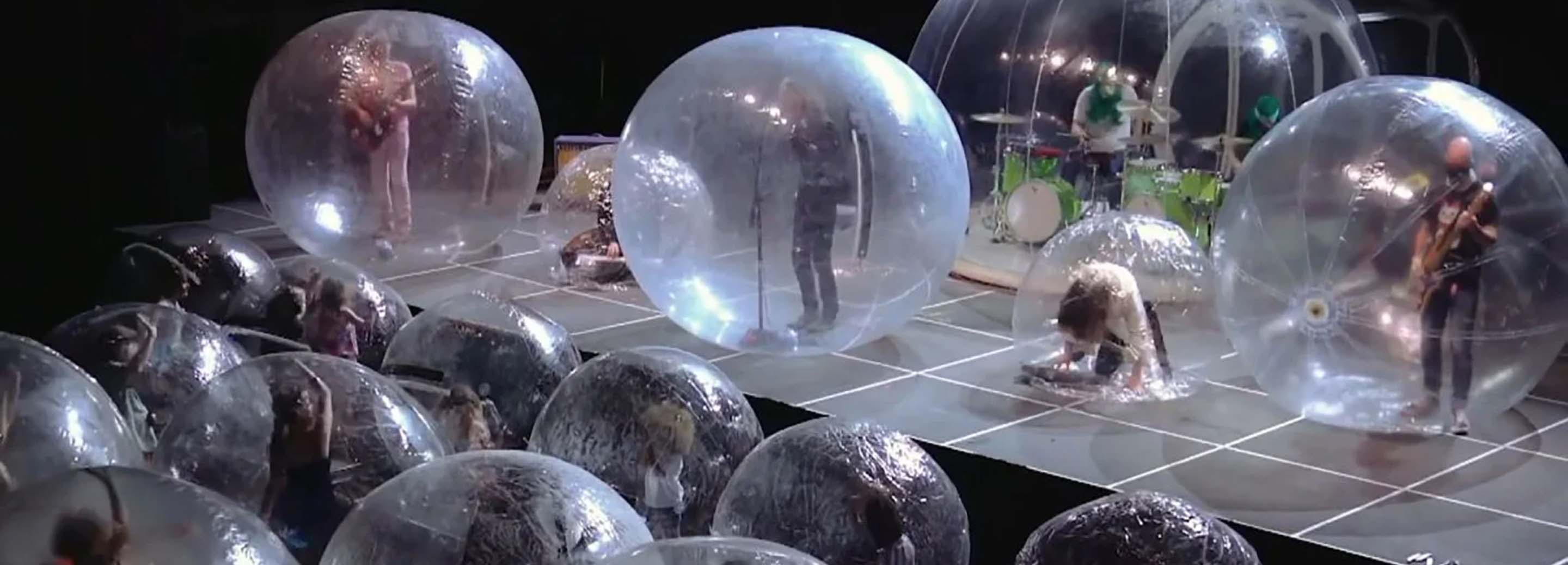
↳ Flaming Lips, Plastic Bubble Concert (2020).
The aspect of connection shows it’s potential in a dedicated server for players with autism on Minecraft, called Autcraft. Autcraft is used by parents to connect in a new way with their children, for instance communicating with their children through the chat function. The creator of Autcraft stated that a child’s previously incomprehensible Minecraft chat can become a shared source of fun, if parents give it a go. Especially the year 2020 showed how important video games can be social interaction. The whole world has to live in isolation because of the Covid-19 pandemic. A lot of people are missing their friends, family and in general connecting with other people. The video game is the perfect medium for virtual meeting spaces all this time. An example of a festival which makes use of this technique is the annual design and creativity festival in Barcelona, Blanc! While I was doing my internship at Studio Dumbar we got invited to participate in a talk about the work produced by the studio. The festival Blanc! made use of online meeting rooms for which every participant had to create a character to be able to watch the talks. While the talk was taking place the participants could freely move around and at the same time chat with their fellow festival go-ers.
↳ Blanc! Festival with Studio Dumbar lecture (2020).

↳ Attendees of the 1981 Space Invaders Championships attempt to set the highest score in Space invader Tournament.
While online video game platforms offer great tools to interact and communicate with each other, Augmented Reality (AR) takes it to the next level. AR is used to enhance natural environments or situations and offer perceptually enriched experiences.

↳ Ocean Albin, Autumn Feelings (2020).
In 2016 Pokémon Go was released by the Niantic company. The new mobile AR game almost forced you to make contact with other players. The game made use of the real world map with GPS, the objective of this game was to catch as many Pokémon as possible, which were spawned randomly in the real outside world. Pokémon Go was a big hype across the whole world, since everybody’s fantasies finally came true: you could catch your own Pokémon and become a Pokémon trainer. For some events in Pokémon Go you had to participate in group activities with fellow players all at one location. For a year or two I also played Pokémon Go. I noticed while playing how the game set up opportunities to let you have conversations with fellow players. It was quite easy to spot someone playing Pokémon Go. On the map you could see the spawn locations of the Pokémons, and there was a certain flicking hand movement you had to perform on your smartphone to catch a Pokémon.
When walking around it would be quite awkward to stand with a group of strangers battling the same Pokémon while not saying a single word. One day I even heard about a WhatsApp chat group for Pokémon Go players in The Hague. In this chat people talked about game updates, meeting up in real life (IRL), playing objectives and calling out others if they were location spoofing. Location spoofing is done by tricking your GPS into thinking you are moving to different places, while you are at another place. Niantic has forbidden location spoofing, since it beats the purpose of the game, to walk outside, discover new places, players and Pokémons. While a big part of the community frowns upon location spoofing, others see great value in this technique. For instance, players who are not able to walk or are too sick to go outside can use it to still play the game. Interesting though is since the COVID-19 pandemic location spoofing has been added as a new function to the game, since Niantic does not want to be blamed for spreading the virus, because essentially Pokémon Go can be used as an application to meet up with people.

↳ Ocean Albin, Daycycles (2020).
Unfortunately, the game failed for me. The focus is on your own journey, rather than how you connect with your fellow players and make new friends. A missed chance to incorporate a good system for players to interact and meet up with each other.
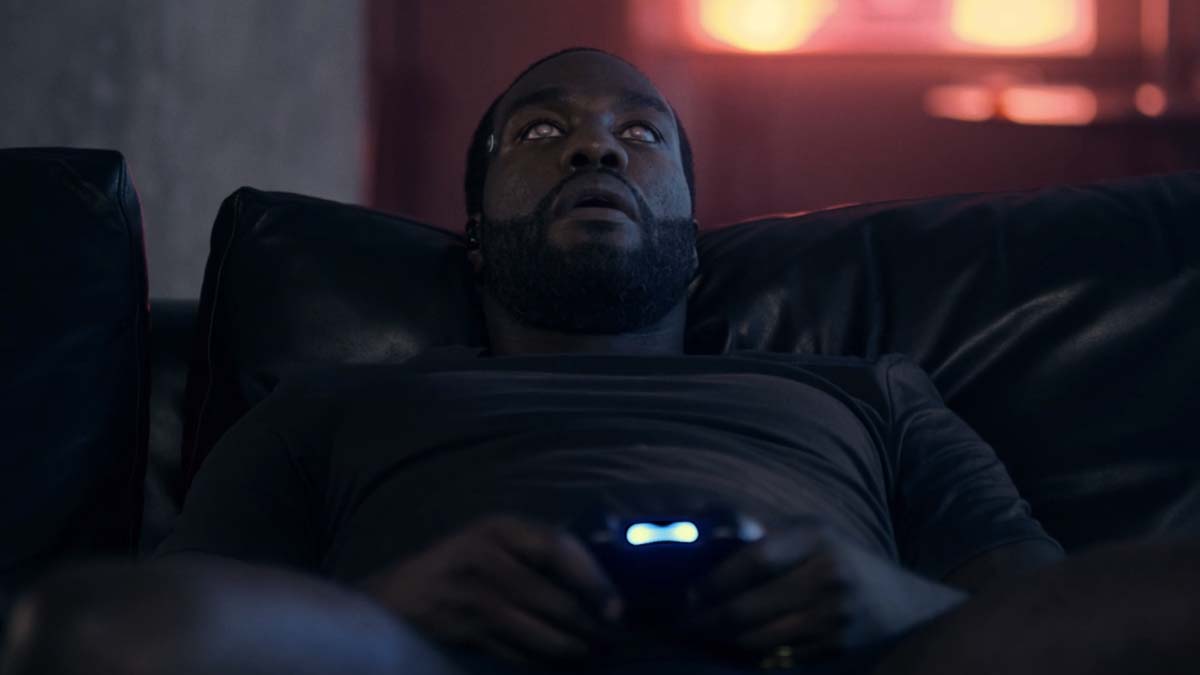
↳ Scene from Black Mirror’s Striking Vipers episode, in which one of the protagonists just entered VR (2019).
In Black Mirror’s Striking Vipers episode there are two male protagonists who explore the next generation Virtual Reality (VR) games, when putting on the VR headset their minds get transported into video game characters. While playing a fighting game (Tekken) against each other, they suddenly feel a very strong urge to make out with each other's digital character, afterwards when they see each other again they feel awkward, since one of them is married.
Although none of my VR experiences got close to the intenseness of this Black Mirror (BM) episode, I see the potential of the medium showing. Once technology is as developed as in BM you could become another person digitally. Up until now everybody's online version on social media is an altered version, not giving the true representation of themself. Countless possibilities and fantasies one can only dream of could be fulfilled. The Striking Vipers episode and my own VR experience came very close to the feeling of dreaming. When putting on a VR headset, you forget all your surroundings and things which are happening around you, just like when you are dreaming. While it can be used as a source for entertainment or a spiritual journey it can also be used to socialize.

↳ The Oculus Rift S Virtual Reality headset.
We live in an age of needing to be connected all the time, social media outlets, such as Facebook, which are trying to let you believe and experience you having an online persona. Recently Facebook bought Oculus, the company which developed VR headsets. The takeover on itselfs already sounds like it could become a BM episode, since the takeover users have to create a personal Facebook in order to use the accessoires. The first steps have been made to recreating the real world inside the VR dimension. In an article written in the New Yorker, Metzhinger believes that virtual killing and sexual violence should be prohibited.[4] He also worries about scenarios that encourage the character traits that psychologists refer to as “the dark triad”: narcissism, Machiavellianism, and psychopathy. He fears the effects of a VR Westworld. Westworld is a series where people can pay money to visit a world with cyborgs who look and interact as real humans. In the series there are some narcissistic characters who enjoy or don’t see the harm of killing a cyborg. There are a lot of video games which involves having to make a decision on killing other characters. It is quite interesting until what level you can kill a person in a video game. My last chapter will elaborate further on that question.
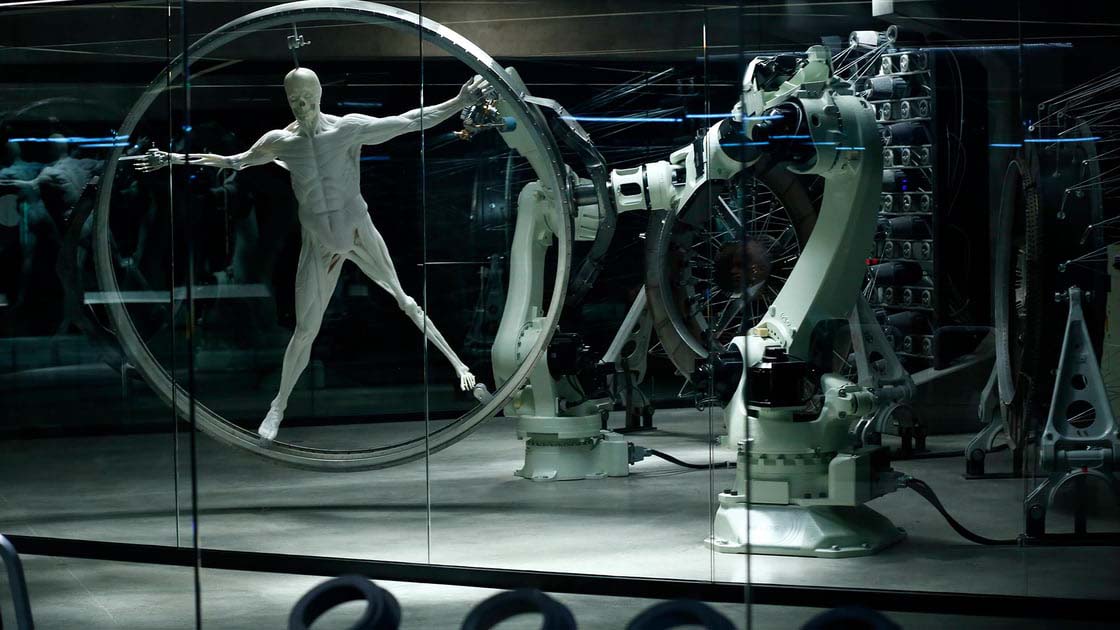
↳ Scene from Westworld, in which an artificial human is being created.
In my opinion virtual killing and sexual violence should not be prohibited, since I think dreaming and gaming in VR are much alike, when you kill or do something wrong in your dreams, should you be able to get prosecuted? While killing in a VR realm is your own choice, it does not represent killing in the real world, same as dreaming does not represent the real world. When a person has wrong thoughts, but does not execute them should this be illegal? While virtual killing and sexual violence are two things which already exist in non VR games, why should they be prohibited in VR games? With this statement games such as Grand Theft Auto are illegal to be developed for VR. VR is still grounded in the virtual world, but when a new technology is developed, surpassing VR and having consequences to the real world, that is where I will draw the line. VR can be used as a tool to disconnect and immerse yourself in a dreamworld, while also having the option to connect, for instance the integration of Facebook into the Oculus systems will pave ways for the future to connect with each other in a virtual space.

↳ This is a hand-built, prototype headset for one of the first VR displays ever built. Developed at the NASA-Ames Research Center in Mountain View, California and completed (1985).
SKILLING
→ a tool for education
In the paper Gaming in Education: Using Games as a Support Tool to Teach History, a group of researchers propose a theory that video games can add great value to teaching methods. Video games help students be enthusiastic, to motivate and engage, reduce boring learning methods, help students focus, while boosting self-esteem and memory.
“A game is a type of play where participants follow defined rules. Games can be used as a support tool to complement traditional teaching methods to improve the learning experience of the learners while also teaching other skills such as following rules, adaptation, problem solving, interaction, critical thinking skills, creativity, teamwork, and good sportsmanship. Learning should not feel dull and it should not only mean rote memorization where students learn and grasp concepts through repetition or cramming. Teachers can take advantage of the energy and innovative thinking that is provided by using technology in learning to improve student performance.” – Victor Samuel Zirawaga [5]

↳ Ocean Albin, Nightcity (2020).
The idea to incorporate gaming into education makes a lot of sense to me, since I experienced myself as well how gaming can help with development. Previously I showed how Runescape can be used as a tool for interacting with others, while it also served me as an educational tool. Runescape was introduced to me when I was 7 years old and I played the game for several years with all my friends from elementary school. This game was set in English and I only spoke Dutch at the time, so by trial and error I figured out what all these English words meant. When I got into middle school I realised how Runescape gave me a big advantage in English class. I remember clearly how my teacher was impressed that I knew the word ‘swamp’ at the time, while nobody in my class knew the word. This shows how video games can help at an early age to help as a tool for learning new languages. While playing video games I was learning without even realising it, so what happens if this medium is further explored and intentionally applied to educational systems?

↳ Ocean Albin, Uncut Gems (2020).
“Games are architectures for engagement.” – Constance Steinkuehler, a professor at the University of Wisconsin [6]
Video games have proven to serve as great tools for education to me, but there are more aspects to this Swiss army knife. Humans are not using 100% of their brain all the time and gaming can help train parts of your brain. With games involving elements of memory, puzzling, trivia, logic and problem-solving, one can enhance their brain function. When playing multiple of these games we are not just using one part of the brain, but most of the brain areas are active and functional.
Research shows 55% of American lower schools incorporate gaming as a teaching method. [7] Students are playing video games focused on learning grammar, learning how to code, while also learning how to socially interact. Since children generally like playing games, rather than doing homework, it is the perfect medium. There are systems designed especially for educational usage, such as Dreambox Learning and Classcraft, which looks a lot like Fortnite: a well known video game with a total player count surpassing a player count of 250 million. Although it separates itself from the fighting genre and lets the teacher use the game environment to teach their classes. To only incorporate learning aspects could get boring after some time for the students. Therefore, the system lets players engage in educational challenges, to earn points. These points can be used to buy cosmetics in game, to listen to music or to buy an in-game pet. When students show bad manners, their points can be taken away. This results in a balanced out learning experience, while having fun at the same time.
“Because it made me a participant with my students—I’m not just their teacher, I’m their game master. I control the fun of the classroom.” – Laura Bruster, a teacher at the Amana Academy in Atlanta. [8]
Video games can implement direct educational methods, to focus on cognitive skills, while an important aspect of the medium is mostly overlooked, the development of non-cognitive which is fundamental for skills, such as patience, discipline, social interaction, persistence, collaboration and problem solving.
“Research shows better developed non-cognitive skills correlate with higher IQ scores” – James Gee, a professor of literacy studies at Arizona State University [9]
The interactivity of the medium also is more promising for learning, instead of making a test and having to wait for some time for the results, video games are able to give direct feedback and therefore create programs accustomed to every level, which is harder to do than in a regular text book. Besides the fact that video games are beneficial for studying and giving direct feedback, the medium is also more environmentally friendly. Unlike textbooks, video games do not have to be published each and every year. A simple patch can be installed in a matter of seconds. While I am a big believer of using video games as an educational tool, it must not replace the already existing educational system, rather functioning as an add-on. There should be a healthy balance of screen time and off-screen time.
MULTIPLAYER
→ a tool for making a career
While gaming can help you with learning in school, some talented people can also make a professional career out of it. Just like other professional sports, athletes can get signed by big sponsors or brands. I introduce electronic sports (Esports) to you, no not Wii-sports, well maybe it is a bit similar… Anyhow Esports gives a platform for big gaming tournaments with huge amounts of prize money. In 2019 a 16 year old boy, Kyle “Bugha'' Giersdorf from America won the first Fortnite World Cup and got 3 million dollars. That is quite the start of a career for someone who just turned 16 years old. Instead of working on their physical stamina, Esporters train whole days on their digital stamina and have coaches look at their gameplay to discuss or introduce new tactics. China was the first country to recognize esports as an official sport. Up to this day debate is still active whether video games can be an official sport. In 2020 the Royal Dutch Football Association (KNVB) started an official Dutch esports-team, called E_oranje with a national coach guiding the team. The KNVB said that they wanted to reach and connect as many people as possible.

↳ Kyle “Bugha” Giersdorf with the Fortnite worldship cup (2019).
“The new generation does not see a difference between online and offline, digital football is part of their football experience, it is only logical that the KNVB adapt to the times. With the arrival of E_oranje we hope to bind more people earlier and longer to our sport.” – Jean-Paul Decossaux, director of the KNVB [10]
While I understand the reasoning behind the message, it simultaneously touches upon a deeply rooted problem regarding the use of video games by large companies or organisations operating for profit. I sense a push to make people more addicted to the game, so they can generate a bigger income. Every company does have an agenda for generating income, but it feels like they want to connect to younger and younger players, how the director is putting it. The KNVB sees that there is a lot of money to be made in this area. For instance, the 28 year old Koen Weijland is 5 times in a row national winner of the game, which earned him the first e-footballer to get signed a professional contract.
“When I started gaming professionally 10 years ago I never thought I would get signed by a club.” – Koen Weijland, a Dutch Esporter [11]
To get signed by a football club as a gamer sends a message out to the world, that esports is getting its recognition to be a real sport. This sounds promising to me, but there are some enemies lurking in the shadows. Nowadays betting is already a big part of the esports culture, just like any other major sports you can place your money on your favourite player or team for winning the tournament. While in the real world these do not appear as real enemies, they become evil when entering your video game. In the last chapter, I will show you these evil enemies: the hidden gambling mechanics present within video games.
CREATIVE MODE
→ a tool for expressing yourself
Video games can also serve as a tool to tell stories or express ideas. Video games are programs written with code. To tell a story through a game you need working code. 2019 was the year I got interested in how to create a video game both technically and visually. I found a piece of software, called Unity, in which I created my first video game. In this game the player had the objective to gather American and Russian intel making sure that neither party would use their nuclear weapons on each other. The player had to act rather quickly, since there were also enemies swarming around and if one of those would grab you it was game over. Your intel would be given to the wrong people and a catastrophic nuclear war would arise. The intel was represented by artefacts from the International Institute of Social History in Amsterdam (IISG), and consisted of items from the Cold War period, retelling the history of the Cold War. After creating my video game The Cold Race, I noticed how my game did not look very realistic.

↳ Ocean Albin, The Cold Race (2020).
This sparked my curiosity on how video games can achieve a sense of realism. Why is it important to achieve realism? When a better sense of realism is achieved you will focus less on visual faulty graphics, while simulating a reality which is more convincing. In my opinion when you get closer to reality your gaming experience gets better, to get more involved and relate more with the graphic that surrounds you and be able to fully engage in the world which is presented to you on your screen. To get a better understanding of how this process works I started experimenting with creating 3D works in a 3D-software program, called Cinema 4D.

↳ Ocean Albin, Abandoned Ritual (2020).
I will show you how creating works in 3D relates to gaming. To be able to render visuals of the game to your screen you need rules. Take a step into the rendered digital world I created, accompanied by explanations of terms and how they achieve realism. With my research I looked into what you need to create a computer generated image (CGI), which feels like a real picture or movie. The ability to generate digital imagery which seems real can be achieved with a multitude of effects.

↳ Ocean Albin, Extra Terrestrial (2020).
Materials are one of the most important parts of modern video games. Take a look around the space that you are right now and notice how all objects have color, reflectance, dents or other properties. For instance, the laptop or printed publication on which you are reading my thesis right now, you can notice how materials are a bit imperfect, there is always a little smudge, wear or dirt on it. So if you create a digital image and there is no wear or dirt applied to your materials, your scene will feel too perfect and make it look like the image is not real. This is an important pillar of creating digital realism.

↳ Ocean Albin, Microscopic Views (2020).
A mechanic which adds more realism to a scene is Ambient Occlusion. When AO is not used the scene can feel a bit dull, all objects have the same “darkness” in the shadows. AO calculates how well every object in a scene is lit and darkens or softens the shadows accordingly. This feature adds great results of letting a game feel realistic. Global Illumination (GI) another mechanic to add more realism to a scene, when GI is an algorithm which calculates how light illuminates a scene and reflects on objects. This effect is seen when a light source shines at a mirror or reflective object and you can see how the reflections are bouncing back on other objects.
The smoothing of edges in the digital world is called Anti-Aliasing. When an object in a scene is not smooth, a problem which sometimes occurs when rendering are ridged edges and anti-aliasing calculates the points in between and will make it smooth.

↳ Ocean Albin, Blurry Gatherings (2020).
A sense of movement in realistic games is also an important aspect. By blurring objects which move at a higher speed, if you take a still, you will see unfocused, or blurriness in a certain direction. This effect is called Motion Blur, which is applied to still from a video I made, as you can see the directional blur of the red balls give a sense of movement.

↳ Ocean Albin, Emitters and Spheres (2020).
To get a realistic looking computer generated image (CGI), you can use Depth of Field (DoF). This is done by emulating a camera from the real world or when you look around you will notice everything is not 100% sharp, you are always focussing on something, blurring other things in your view. In a render I made, recreating molecule atoms I used DoF to give a sense of size of these particles, the further away the particles are in the background, the blurrier they become.

↳ Opening scene from Alfred Hitchcock’s movie Vertigo (1958).
So when did CGI become relevant and how is it used in the past to express creative ideas? 1958 was the first time CGI was used in a creative way in cinema. Alfred Hitchcock’s Vertigo was the first movie to introduce this new concept to the world. Since 1958 CGI has made big leaps in advancements. CGI is mainly used to create imagery which is hard or expensive to create physically. Back in the days, big sets would be built or the movie would be shot out in the open. Now it is cheaper to create a set like this completely digital and make use of blue or green screens. The only problem with these screens is that you had to know beforehand how your scene would be lit. Otherwise you had to change the lighting in the scene afterwards.
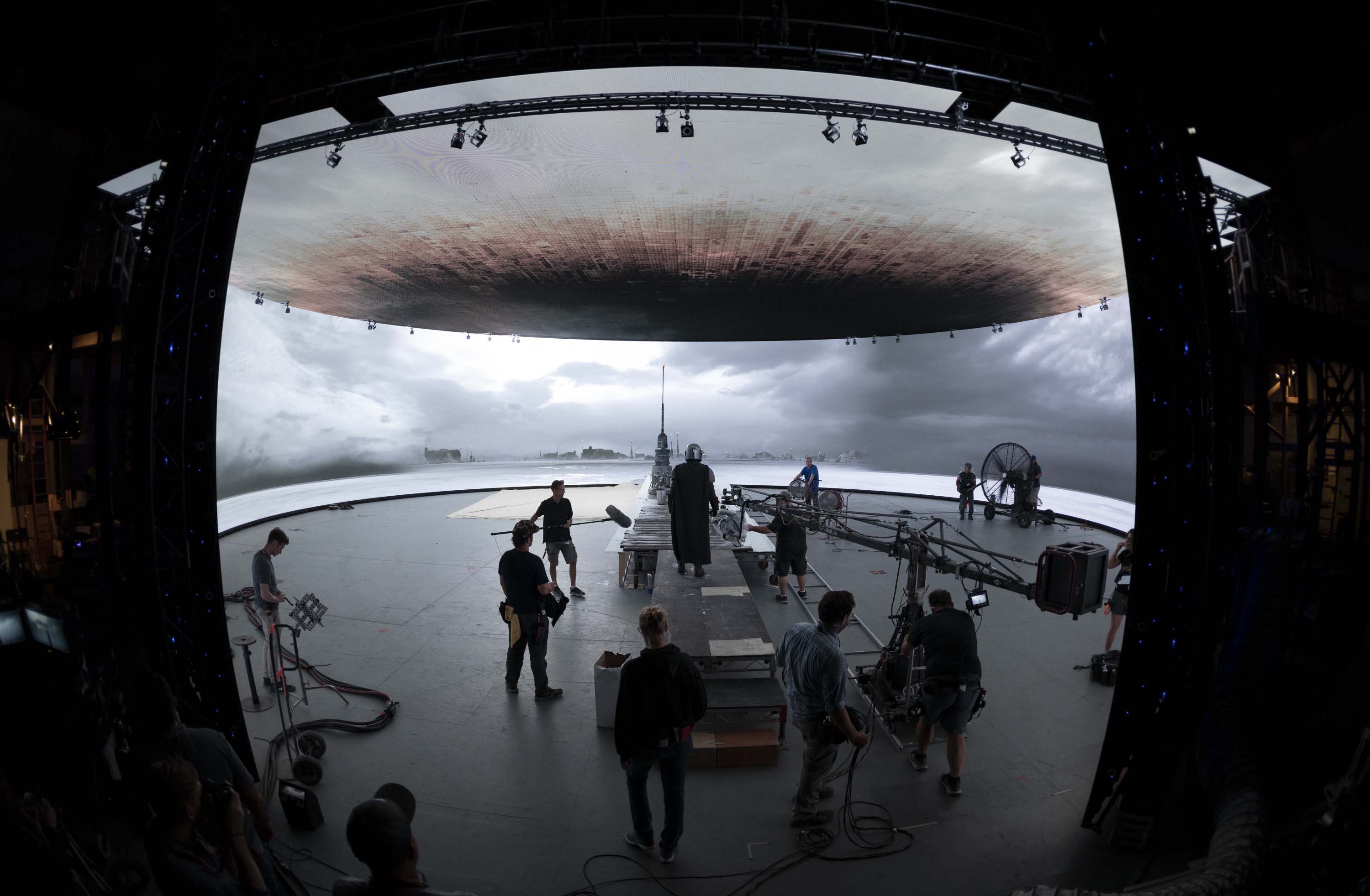
↳ Set of The Mandalorian, a half circular wall made up of millions of LED lights, which moves the screen according to the movement of the film camera (2019).
For the Disney+ show The Mandalorian a new technique has been developed with the help of the video game engine Unreal Engine and a big wall of LED lights. On the camera are 3D sensors placed, so Unreal Engine knows where the camera is in 3D space, and according to this information makes the camera move so it looks like the background is real. This technique has multiple advancements over a greenscreen. The film production crew can see better how the scene looks and feel more comfortable shooting, instead of having to imagine how the environment looks like in a green room. In The Mandalorian, the main protagonist wears shiny metallic armor. It is very hard to emulate the reflections on such armor when using greenscreens, but with the wall of LED lights the reflections are real, so there is no need for extra post processing work. Because the software is in real-time, the director of photography can change the virtual set in a matter of seconds. Which before took countless hours to apply afterwards, can now be generated in the blink of an eye.

↳ Fortnite Travis Scott Event: Astronomical, 2020.
Due to the covid-19 pandemic new ways of the video game medium have been explored, game developers created in-game events to connect with their audiences. A good example of an in-game invention is Epic Games’ Fortnite, in which they made an in-game music show of Travis Scott, which saw over 12 million concurrent views from players. Epic Games uses famous people to elevate their game to new heights. This marketing trick did not originate from within the gaming world. For instance, George Clooney is used by Nespresso to create affiliation with the brand. However, the gaming industry brings this concept to a new level. Now you can interact with famous people. Cd Projekt Red, developer of Cyberpunk 2077 uses a digital version of Keanu Reeves as their promoter and in-game character. This intrigues me; video game companies are making these people immortal—their copies will live on long after they die.

↳ Keanu Reeves as Johny Silverhand in Cyberpunk 2077.
Lately it has become easier to reproduce something photoreel in 3D at home. You can basically walk around an object and take pictures of it, and let a program stitch it all together. Now you have a copy of yourself or an object which you can place in new environments or save it on a harddrive for later generations to let your grandkids see how you used to look like in a 3D space. Last year I also eternalised myself: using a 3D scanner I got a scan of myself and I reproduced myself in 3D software. 3D scans could be seen as a way of archiving and even, when applied to a medium such as a game, can be seen as a statue. People who make statues from themselves want to be remembered, want to be part of history, but also by making a statue of yourself you are creating a true version of yourself, so people can not view you in another way.

↳ Ocean Albin, Me (2020).

↳ Ocean Albin, Myself (2020).

↳ Ocean Albin, I (2020).